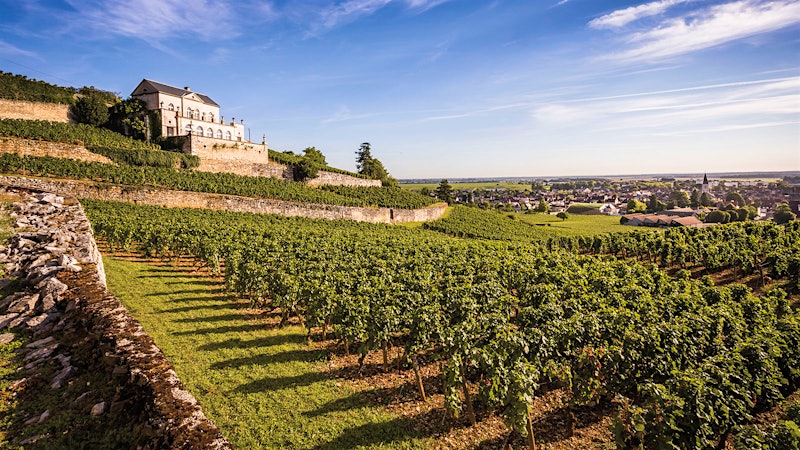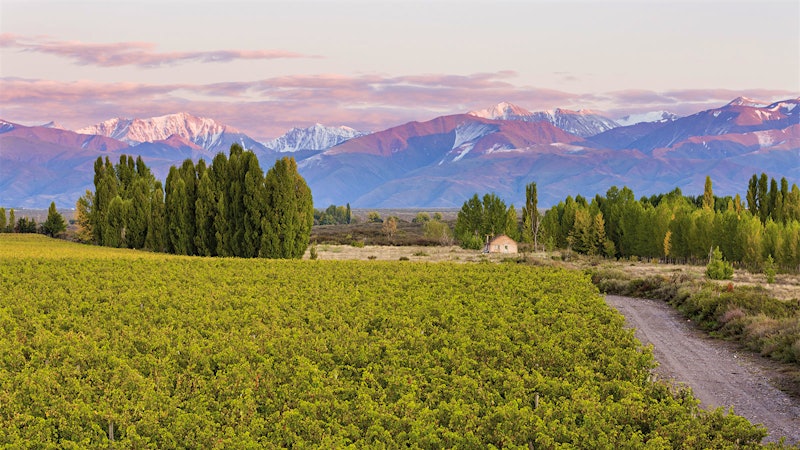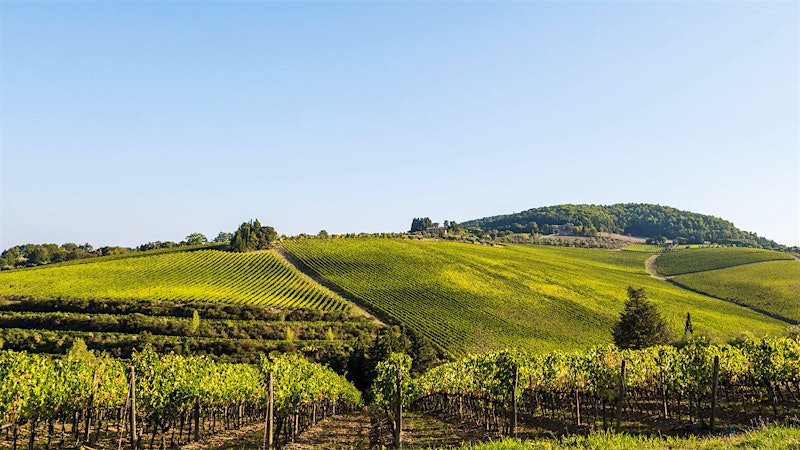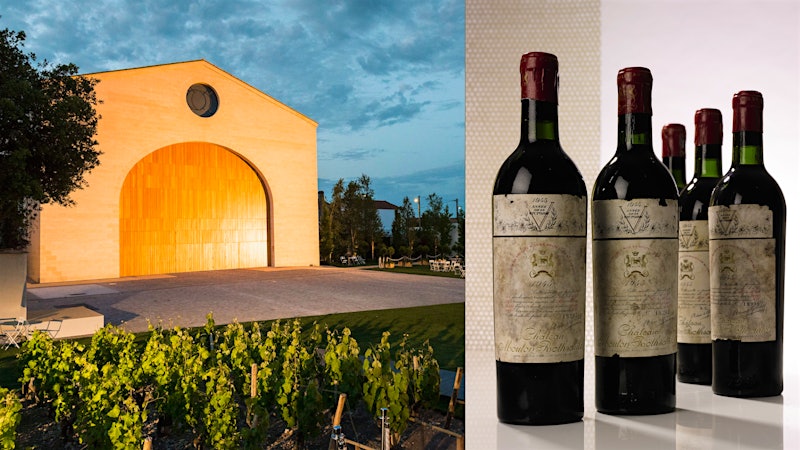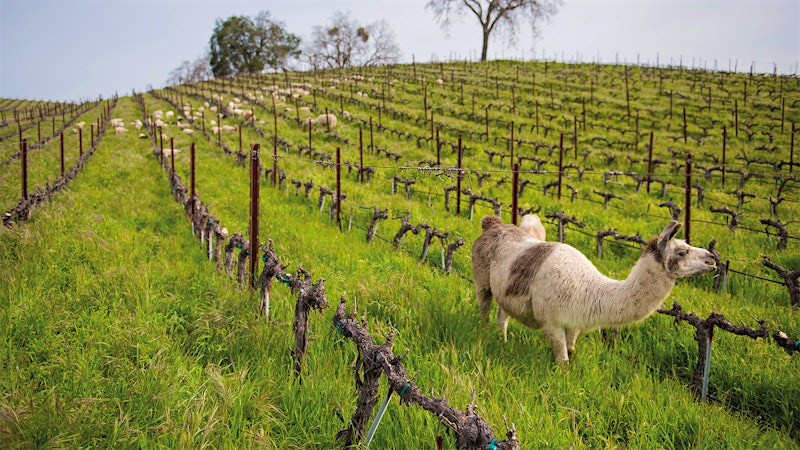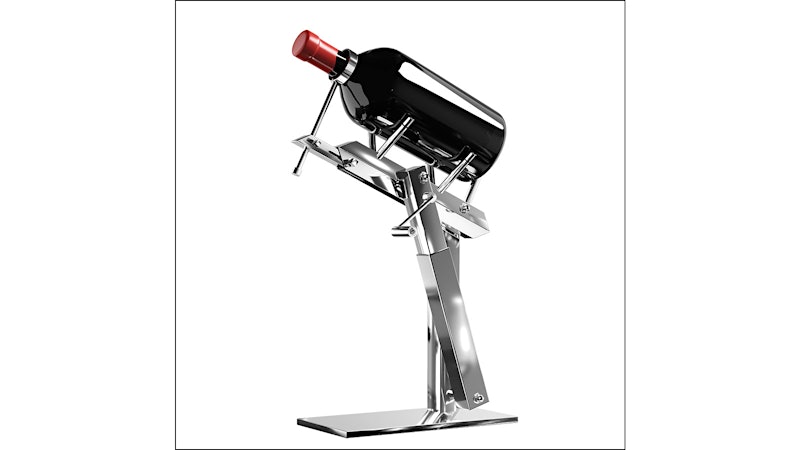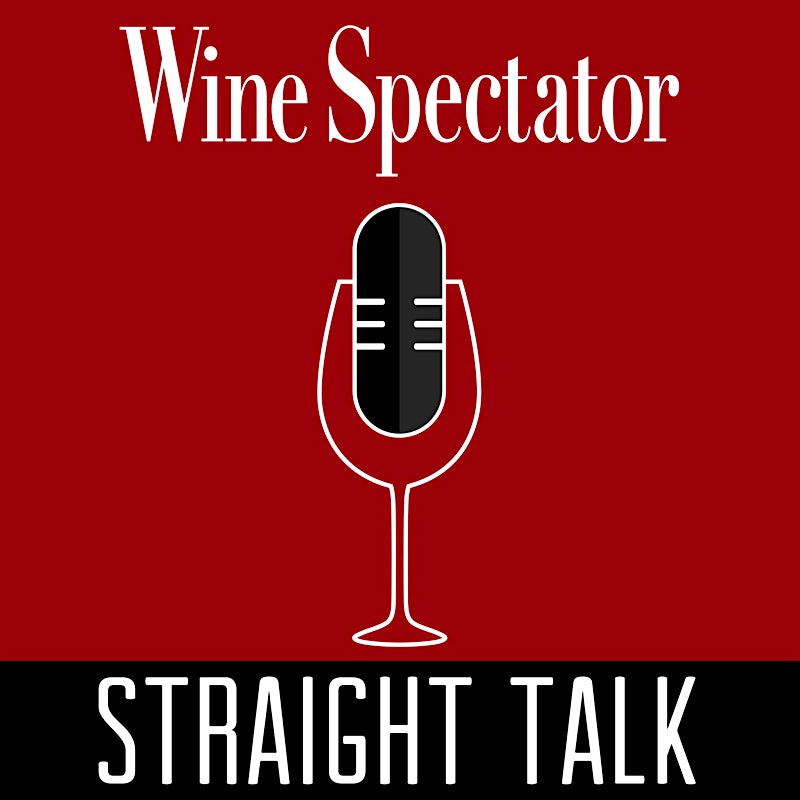Every year, people around the world pop millions of bottles of Champagne, particularly on special occasions like New Year’s Eve (among other Dec. 31 traditions). But what’s the story behind the world’s most famous sparkling wine? Where and how is it made? To answer these effervescent questions, we offer this handy primer that moves through each step of the Champagne production process, from vineyards to clinking glasses. (For more, get senior editor Alison Napjus’ latest Champagne tasting report.)
Where Does Champagne Wine Come From?
Champagne comes from the Champagne region of northeast France, and it can only come from there. The majority of wines made in Champagne are sparkling, though non-bubbly Coteaux Champenois wines are also produced there. (These aren’t easy to find in the United States).
Wines made in one of Champagne’s 17 most prestigious villages are permitted to include the grand cru designation on their labels. These villages—such as Ambonnay, Avize, Oiry and Verzy—are considered to have the finest terroirs for Champagne production; their vineyards are highly valued and their wines are sought after.
Champagne in the Vineyard
As with all grape wines, Champagne starts with vines. Vitis vinifera vines to be exact. The Comité Interprofessionnel du Vin Champagne, which oversees the Champagne AOC, regulates which grape varieties can be grown there and how these vines are trained (that is, maintained).

Only seven vinifera varieties are permitted to be grown in Champagne: the white varieties are Chardonnay, Pinot Gris, Arbane, Petit Meslier and Pinot Blanc and the reds are Pinot Noir and Pinot Meunier. Of these, Chardonnay, Pinot Noir and Pinot Meunier are predominantly used in Champagne, and most of these sparkling wines are primarily blends of Chardonnay and Pinot Noir, with small amounts of Pinot Meunier.
There are Champagnes made exclusively from Chardonnay—known as blanc de blancs—and others made solely from the white juice of Pinot Noir (blanc de noirs). A few are even made only from Pinot Meunier or Pinot Blanc grapes.
If you really want to get into the vineyard details, the CIVC only permits four vine-training techniques: taille Chablis, cordon du Royat, taille Guyot and taille Vallée de la Marne. (Don’t worry too much about the details here, unless you’re planning on working in a Champagne vineyard; the main thing to remember is that Champagne vines, and even crop sizes, are highly regulated.)
What Is Grower Champagne?
Many Champagne houses, particularly the largest, will buy their grapes from grapegrowers in the region, with whom they often have close, long-lasting ties. Sourcing and blending from multiple locations allows these négociant houses to achieve consistent levels of production.
But some Champagne producers make wines exclusively from vineyards that they farm themselves on land they own. These are known as “grower-producers” (or récoltant-manipulant in French). As these wineries tend to be small, their wines occupy only a small portion of the overall Champagne market. Notably, because grower Champagnes are made from specific vineyard sites, they are often applauded for their ability to express a specific terroir.
Get scores and tasting notes for recently rated Champagnes!
Harvest Time

Grapes in Champagne are traditionally harvested around the start of autumn, and sometimes earlier, in the later days of summer—to preserve vibrant levels of acidity in the fruit. Harvest is carried out exclusively, and very carefully, by hand, meaning no machine harvesters are permitted. The quality of grapes is then determined through meticulous sorting.
Pressing the Grapes
Soon after harvest and sorting, the grapes—separated by variety—are gently pressed to avoid too much contact between the juice and the skins, which contribute color. The goal here is to keep the juice pale in color (except when making rosé wines—more on that later). But there’s a twist! The grapes are actually pressed twice: The first round releases sought-after juice known as cuvée, while the second pressing releases juice known as taille. How the taille is used for winemaking depends on the particular Champagne producer. As with most things in Champagne, the pressing is heavily regulated to maintain consistency in the region.
A Note on Saignée
You may have heard the word saignée used in reference to winemaking, particularly when it comes to Champagne. This literally means “to bleed” in French, and it refers to the process of pulling pink juice from a tank of crushed red grapes that have been allowed to macerate for a brief time (that is, the juice is left in contact with the grape skins). The skins’ color has “bled” into the juice, hence the name.
This juice can be used to make dark, rich, structured rosé Champagnes. However, this method of making rosé Champagne is rare compared with the more favored technique of blending. (More on that after the next step … .)
Fermentation: Making the Base Wine
With must (unfermented juice) at the ready, the next step is—as with all vino—the fermentation. Here, many houses use the yeast species Saccharomyces cerevisiae to consume sugars in the must and produce alcohol. Each grape variety is generally fermented separately, and houses will often ferment different lots—distinct selections from each harvested vineyard plot—separately as well.
At this stage, the resulting wine—known as the “base wine” in Champagne—is still and usually very acidic.)
Note: This is only the first fermentation of two, but more on that to come.
Blending a Champagne
As with many other wines, Champagnes are often produced by blending base wines made from different grape varieties and lots. Each Champagne house has its own methodology when it comes to blending (aka assemblage), in order to create distinctive house styles and cuvées.
Blending Rosé
Winemakers planning on creating a rosé Champagnes will also have fermented some still red wines from Pinot Noir and Pinot Meunier: They can then blend white and red base wines to create their house’s preferred style of pink. Usually only a small percentage of red wine is used, anywhere from 5 percent to 20 percent.
Vintage versus Non-Vintage Champagne
This is the stage at which Champagne houses create their vintage and non-vintage bottlings. Ever noticed that some Champagnes will display a year and others won’t? That’s because Champagne houses choose to make some sparkling wines from one vintage (the year when grapes were harvested) and others from a blend of multiple vintages.
Vintage-dated Champagnes are typically made in the best-quality years when a house wants to preserve the unique characteristics imparted to a wine by the conditions in that particular growing season.
What Is a Multi-Vintage Champagne?
Notably, some Champagne houses, such as Krug, differentiate blends as “multi-vintage” Champagnes, rather than non-vintage bottlings. The difference is that these houses are trying to create a wine with distinctive character based on a blend of particular vintages, rather than one with a consistent house style from year to year.
Élevage: Raising Champagnes as Their Own

With the wine blended, it’s now time for élevage (meaning “raising”), when Champagne houses shape their wines. Here, some houses may place their wine into oak barrels, or they may opt to initiate malolactic fermentation, which can enhance the wine’s mouthfeel and flavor profile. The main idea is to add to the wine’s character, creating a sparkler with complex flavors and textures.
To make non-vintage (or NV) Champagnes, producers will blend their fresh base wines with reserve base wines made in previous years. While this decreases the distinctive, vintage-related character of the latest wine, it helps to create a consistent style from year to year. Customers can expect a specific “character” or “profile” from a Champagne house’s non-vintage bubbly.
For some wineries, this reserve wine may actually be the sum of multiple reserve wines consistently blended together and added to over the years, similar to the solera system used to make Sherry.
Bottling Champagne

Once the Champagne house is satisfied with its level of élevage, the wine is placed in the thick-walled (to handle all the pressure inside), distinctively shaped bottles that we all recognize, whether that’s a 750-ml bottle or another size.
A note on Spécial Club Champagne bottles: While Champagne bottles are generally standard in shape, there are some that stand out in terms of shape and color. This includes bottles of Spécial Club Champagne: Since 1971, a group of grower Champagne producers have joined together as the Club Trésors de Champagne to promote their wines. Each of the 24 members submits its finest vintage Champagne—made from vines it owns and farms—to the club. Independent enologists blind-taste the wine twice to determine if it can qualify as Spécial Club, and if it does, the wine is bottled in a distinctive, squat bottle with the Spécial Club designation.
Méthode Traditionnelle: The Key to Champagne
Now we come to what is perhaps the most important moment in the production of Champagne: the secondary fermentation (sometimes known as the second fermentation). This process is known as the méthode Champenoise (aka méthode traditionnelle, méthode classique or metodo classico). Why is it so important? Because this is the labor-intensive process that gives Champagne its bubbles. So how does it work?
Note: While this method originates in Champagne, it is used around the world to make sparkling wines like Spain’s Cava and Italy’s Franciacorta, among others.

Starting the Secondary Fermentation
To kick things off, winemakers add liqueur de tirage (a solution of wine, yeast and sugar) to bottles of base wine before sealing them with a crown cap. This begins the secondary fermentation within each bottle, resulting in carbon dioxide (that’s the bubbles!) and spent yeast cells known as lees. When wines form bubbles, this is known as prise de mousse.
This differs significantly from the other major method of making sparkling wine, the Charmat method (aka the tank method), which is less expensive and labor-intensive: The secondary fermentation takes place in pressurized tanks, not individual bottles, before it’s filtered under pressure before bottling.
Racking the Champagne Bottles
With their bubbles developed, the bottles are moved to special racks known as riddling racks (aka pupitres), which are usually located underground in the cool chalk caves beneath a Champagne house. The Champagnes are initially racked horizontally so that spent yeast cells fall to one side of each bottle.

Aging the Champagne
This is the point when Champagne houses age their wines on the lees. It’s actually a requirement that Champagnes be aged on their lees for at least 12 months before disgorgement (we’ll get to this shortly). This said, a head Champagne winemaker (aka chef de cave) may choose to age a wine for even longer. This lees aging can give the Champagne a richer texture and more complexity, including bready or nutty notes.
What Is the Riddling Process?

Once lees aging is complete, it’s time to begin the riddling process (aka remuage): Invented by the famed Madame Clicquot (Barbe-Nicole Clicquot Ponsardin) of Veuve Clicquot, this is the method of giving racked bottles a sharp quarter-turn every day while gradually tilting them upside down. This way, all that yeast sediment collects in the neck of the bottle. While this was traditionally done by hand in the past, it is now common to use mechanical riddling machines.
Once the yeast cells have collected in the neck, the bottle is placed fully upside-down; this step is called dépointage. Altogether, riddling must take place across a minimum of six weeks, but it can sometimes last several months.
Disgorgement: Getting Rid of the Lees

Now it’s time to get rid of that sediment collected in the neck of the bottle. (We wouldn’t want it in the final Champagne, would we?) But wait … aren’t the bottles sealed with a cap? How do you get the lees out? Disgorgement (or dégorgement), that’s how.
To begin the disgorgement process, winemakers use an ice-cold brine solution to chill the neck of each bottle to the point that the dead yeast cells freeze into an icy plug. Next, they remove the cap from the bottle, which has built up so much pressure during the secondary fermentation that it naturally pushes out the plug of spent yeast cells, as well as some wine. Time for a refill …
Dosage: A Welcome Addition
Now that the bottle is unsealed, and a bit lighter, it’s topped up with dosage (aka liqueur d’expediton), a small amount of wine that is often, but not always, mixed with sugar.
What Are Champagne Sweetness Levels?
The level of sugar in a dosage will vary depending on how sweet a winemaker wants the Champagne to be. After two fermentations, any sugar added to the bottle will be residual (not consumed by yeast), increasing the actual sweetness of the wine. Many years ago, sweeter Champagne was the more common style, but this is generally not the case today, and most Champagnes are now made on the dry side.
Champagnes are generally labeled to indicate their level of sweetness (which would indicate how much sugar was in their dosage during production). Most Champagnes are labeled as brut, meaning they have 0 to 12 grams of residual sugar per liter. But there’s a range of designations. For instance, the driest level of Champagne is brut nature (aka zero dosage), which is used for wines with 0 to 3 grams of residual sugar per liter; more specifically, there is only “natural” residual sugar in the wine, as no sugar was added with the dosage.
From driest to sweetest, the levels of Champagne sweetness are: brut nature, extra brut, brut, extra-dry (or extra-sec), dry (or sec), demi-sec and doux.
Closing the Champagne Bottle

At this stage, winemakers are left with a bubbly Champagne, one with its own flavors, aromas and textures. In the glass, the wine will also show a particular mousse, the froth that forms at the surface of the wine.
But wait … the bottles are still open! Yes, with their finished bottles in hand, it’s now time for winemakers to reseal their Champagnes with those recognizable mushroom-shaped corks. To secure the corks in the bottle, most Champagne houses use a wire cage (muselet) with a plaques de muselet, a small metal capsule (and occasional collectible) that covers the top of the cork and usually IDs the Champagne house that made the bottle.
What Are Agrafe Champagne Closures?
You may occasionally encounter a Champagne bottle sealed with a cork and an agrafe closure, rather than a cage. Meaning “staple,” an agrafe is a metal clip that was traditionally used to hold in Champagne corks during their second fermentation and, following disgorgement, after corking. While Champagnes are not sealed agrafé nearly as often anymore, a few houses still seal wines this way.
Opening a Champagne sealed with an agrafe can be difficult. Some Champagne fans might look to sabrage as a solution. That is, using a special Champagne saber (and the pressure in the bottle) to remove the cork from the wine, along with most of the bottle’s neck. Whichever method you use to open your Champagne, please be safe and responsible. (For more tips, watch this helpful video guide.)
Another Round of Aging

At this stage, Champagne houses age their bottles even longer. Indeed, non-vintage bubblies must receive at least 3 more months of additional age if they only spent 12 months aging on their lees. And vintage Champagnes must spend at least two more years aging, in addition to the 12 months spent aging on lees, before release, though this aging period is often longer. If it adds to the character of the wine and creates a finer bottling upon release, Champagne houses may choose to age the wine for many years. This is why you may see a 2014 vintage Champagne released in 2024.
The Wines Are Released!
It’s time for what many would argue is the most enjoyable part of the Champagne production process: when the finished wines are sent to markets around the world for us to drink. And then comes the hard part for bubbly fans: Vintage or non-vintage? White or rosé? Brut or brut nature? Coupe glass, Champagne flute or a regular wine glass? Do I drink the Champagne now or keep it aging in bottle for later enjoyment?
Whatever you choose, we recommend that you take a moment to remember, and give thanks to, the many hardworking vineyard and cellar workers, chefs du caves, salespeople—and all others—who devote their lives to producing and promoting the world’s most celebrated sparkling wine. To them, we lift our glasses high and say, “santé!”



